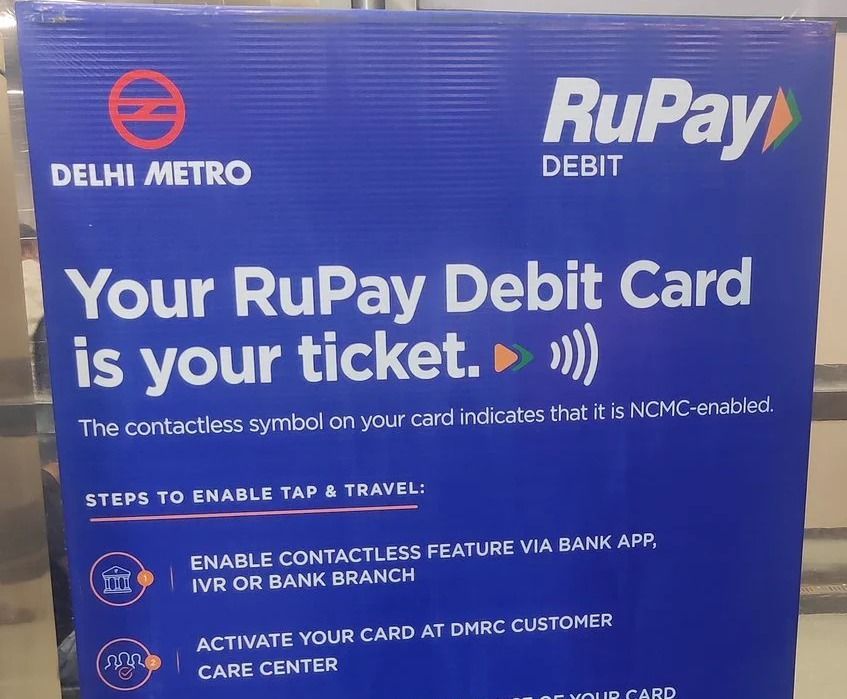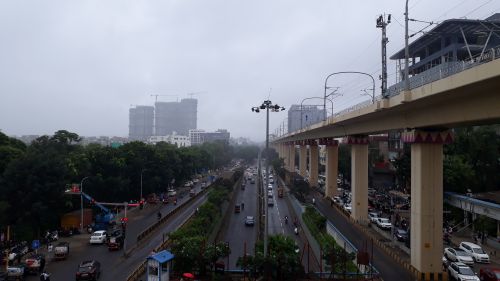After trying out the Aqua Line of Pune Metro last month, I recently checked out the Purple Line. When it’s fully commissioned, this route will connect PCMC on the north to Swargate in the south of Pune. As of now, Purple Line is operational between PCMC and the downtown Civil Court station. Two stations on the way – Khadki and Range Hill – are not yet open.
As I mentioned in my blog post entitled Pune Metro First Impressions, Civil Court is the interchange station between Aqua Line and Purple Line.
My route had four legs:
- Ruby Hall Clinic to Civil Court via Aqua Line
- Civil Court to PCMC via Purple Line
- PCMC to Civil Court via Purple Line
- Civil Court to Ruby Hall Clinic via Aqua Line.
I bought a return ticket for the full journey. For reasons that will become clear soon, I had to buy another ticket for the last leg.
Here are my second impressions of Pune Metro based on this trip.
1. FAST
The Purple Line train is faster than the Aqua Line train, not only in the Civil Court-to-Shivaji Nagar underground but also in the Shivaji Nagar-to-PCMC overground section. It took 25 minutes from Civil Court to PCMC. According to Google Maps, this distance of 15 kms would would take 35-45 minutes by road.
2. SCENERY
Thanks to the elevated perspective, I saw some places that have not registered from the ground level in the past. Such as this nice garden just outside Ruby Hall Clinic station.
3. CIVIL COURT STATION
I’ve seen many metro stations abroad and a few in India. They’re typically a hole in the wall at the street level. While many of them are sprawling inside, I don’t recall any of them having much of a footprint outside.
Civil Court is an exception.

As you can see, the station is a largish and impressive building set on a wide open space with wide driveways and a biggish parking lot.
When I first saw the building, I thought it was the Civil Court after which this metro station is named. But, when I went up to a security guard to reconfirm, he told me it was the metro station building itself! I still wasn’t sure, so I walked up to it and found out that the entire thing is indeed the metro station.
The station is also sprawling inside. The Aqua Line station is one level above street level. The Purple Line is three levels below the street level. The escalators in Berlin, Munich and other metro stations that have platforms three or more levels below the ground are extremely steep and quite scary the first time around. Unlike them, the escalators in Civil Court station have a very gentle slope.
Shout out to the architect that designed this station.
Just to be clear, I’m talking of “pure-Metro” stations i.e. stations that have no trains other than metro. I haven’t been to Moscow but I’m told that many pure-metro stations on the Moscow Metro look extremely imposing from the street-level.
4. TRAIN
Needless to say, Purple Line trains are not very different from Aqua Line trains.
However, I found a glitch with the LED display on my Purple Line train. As soon as a train pulled in to the platform at Civil Court station, I asked a guard if it went to PCMC (which is where I wanted to go). He said yes. However, after getting into the train, I noticed that the arrow on the route map pointed towards Swargate. I was wondering if I got into the wrong train. When I asked around, one of my fellow commuters assured me that the train was indeed headed towards PCMC (phew!). By that time, the display refreshed and the arrow turned around to the correct direction. I also learned that the section from Civil Court to Swargate was not even operational, which made it all the more inexplicable why the arrow should point towards Swargate at all.
5. PCMC
I haven’t been to Pimpri-Chinchwad area in years. When I got off from my train at the last stop (PCMC) and had a look around, I was stunned by how bustling it was!
6. TICKETING
Ticket booking at Pune Metro stations continues to be PITA.
According to Pune Mirror, self-service kiosks are frequently out of order.
Not surprisingly, almost all passengers were carrying paper tickets. They were all also carrying smartphones and using WhatsApp and other apps. This is another nod to my enduring belief that even otherwise digitally savvy consumers prefer physical to digital when they’re new to a product, whether it’s a metro ticket or a checking account.
Whether it's HDFC Bank in India or JPMC in USA, the most valuable banks in the world grow deposits by expanding their branch network. Because that's where they sell the best. https://t.co/YBvp7yFf5u pic.twitter.com/uA72ZJm6u5
— Ketharaman Swaminathan (@s_ketharaman) August 7, 2023
I booked my ticket using the eTicket option described in my previous post. However, the network at Civil Court station was patchy. When I reached the turnstile, the eTicket on my WhatsApp refused to open. The turnstile inspector told me that it was a standard problem and advised me to buy a paper ticket the next time. (Since the paper ticket has a printed QR code, it has no dependencies on the network.)
I didn’t see a single counter selling the One Pune prepaid card in any of the three stations I visited on this trip.
7. WHITHER DIGITAL INDIA
 A few days ago, Pune Mirror reported that One Pune card sales had caught on. But, on my total of three trips on Pune Metro so far, I haven’t seen a single passenger tapping a card.
A few days ago, Pune Mirror reported that One Pune card sales had caught on. But, on my total of three trips on Pune Metro so far, I haven’t seen a single passenger tapping a card.
Besides, I’m surprised that Pune Metro didn’t take the opportunity to leapfrog the ancient prepaid card technology and opt for the modern mass transit ticketing technology that lets passengers use their regular contactless debit and credit cards as tap in-tap out tickets, especially considering that it’s been around for a long time in London (~10 years) and other cities in the world.
This is another reflection of a clearly visible trend:
- Where government has control via ownership or regulation, India has fairly advanced digital products e.g. UPI (70% of banks are government-owned), CoWIN vaccination portal (by government decree, Covid-19 vaccines had to be booked and logged on this portal run by Ministry of Health and Family Welfare whether they were actually administered in government or private sector hospitals all over the country).
- Where private sector – or even quasi-government – players dominate, few modern digital technologies have gone mainstream in India compared to other trillion dollar economies e.g. Open tolling on highways à la ERP in Singapore (launched in 1998) and E-ZPass in USA (since 2004); EV battery swapping; motion-sensitive lighting in office buildings and public places, Internet on domestic flights, robot parking systems in buildings; etc.
While digital has made great strides in payments & other areas of finserv in India, it lags behind in transportation e.g. Digital Ticketing, Open Tolling, Parking Meters.
Anyone has an idea why this is the case and what can be done to change it? https://t.co/HkG12P7buK— GTM360 (@GTM360) July 7, 2022
I must hasten to add that this is not a plug for government intervention in business but a gentle reminder that multiparty networks require IT systems from multiple companies to work together, and what’s often ascribed to technology chops is explained by brute force distribution, which cannot be applied in all countries.
To give an example of multiparty system that does work, let me take the transportation network in Germany. A typical trip from my home in Frankfurt to my customer’s office in Munich traversed a tram (Strassenbahn) in Frankfurt, intercity high speed train (Intercity Express) between Frankfurt and Munich, and underground subway (U-Bahn) in Munich. Even though the three modes of transport were run by three different companies, I could buy a single ticket for the entire journey online. 20 years later, I haven’t seen an example of seamless intercity multimodal transport ticketing like that in any other country. (While OysterCard does work across tube, bus, DLR, ferry and all other TfL modes of transport in London, it does not work on intercity trains or public transport networks in other British cities.)
8. AQUA LINE
Since I needed to change lines, I thought of checking out the metro map on this trip, something that I’d not done on my first trip. I learned that it’s called Aqua Line, not Blue Line. I’ve updated my previous post accordingly.
9. PSA
As mentioned earlier, I’d bought a return ticket to-and-from Ruby Hall Clinic. On the way back, I tapped out of Purple Line at Civil Court station since I wanted to explore the station from the outside. After completing my sojourn, I re-entered the station on the Aqua Line side towards Ruby Hall Clinic. When I tapped my phone on the scanner, the light above the turnstile flashed red. From this, I’m inferring that my eTicket expired when I tapped out of Purple Line. I had to buy another ticket from Civil Court to Ruby Hall Clinic.
From this data point of one, I’m jumping to the conclusion that Pune Metro does not allow “break journey” at intermediate stops. AFAIK, this is a feature, not bug, of single journey tickets on all mass transit networks in the world.
10. PROTIP
Buy the eTicket before leaving home. Tap the Open eTicket link on WhatsApp immediately. Take a screenshot of the QR code on the next screen and save it in your phone’s Gallery. Use that image to tap on turnstiles. From personal experience, they flash green, so this trick does work!
By effectively transforming the eTicket to a paper ticket, the screenshot removes the dependency on network signal at the station.
You can thank me later:).




